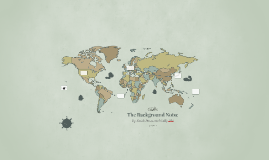The Background Noise
Transcript: Churchill uses the bulldog as propaganda to represent the relentlessness of holding the British line during war. From the Disney propaganda short film "Der Fuehrer's Face" representing Donald Duck making fun of Hitler's claims as a leader, portraying him as the enemy. National security intensified during the war, referencing this piece of propaganda that someone is always watching and monitoring you. During World War II, the television broadcasts ceased, but radio kept the nation well informed of the events of the war while providing drama, music, commentary, and children's programs that brought hope to a nation under siege. The Background Noise World War II : Natalie Bergman and Allison Peto Propaganda Additionally, messages of women working during the war were trageted at the home front. Propaganda also was utilized because it could be the winning or losing factor in a war. It could motivate soldiers, instil hatred for the enemies, and keep support on the home front. Radio broadcasting, music and propaganda played a major role in World War II. The ability to access information more efficiently helped nations under siege and at war. "Lili Marleen" How were radio programs made appealing? Music Radio Hitler saw the condemnation of American jazz as part of a larger plan to liberate Germany from the "deadly embrace" of "Jewish cultural Bolshevism." As a result, "popular" music in Germany consisted largely of official patriotic songs associated with the Reich, folk songs, and some ballads. Strangely enough, one of these ballads had the unusual distinction of being popular on virtually every front in Europe. "Lili Marlene," written by German soldier Hans Leip in 1915, was as popular with Allied troops as it was with the Germans. The range of popular songs was enormous. There were patriotic songs, designed to inspire support for the war effort as well as for the realities of day-to-day life during the war ("Cowards over Pearl Harbor," "America Calling," and "There'll Always Be an England").There were songs directly related to military service, some with specific references to the commanding officers ("Keep Your Powder Dry," and "Here's to You, MacArthur"). Sentimental songs of love and separation were particularly popular ("We'll Meet Again," "White Cliffs of Dover," "In the Mood"). Many shows that aired at the home front during the war incorporated a character from battle who had either returned home due to extensive injuries or highlighted the family of a fallen soldier. Radio What genres of music were popular? A radio broadcasting of "The Liberty" recorded on NBC. Propaganda programs were made appealing because of a revolutionary aspect of new technological advances. Radio propaganda became an influencial tool because it ignored national boarders and made enemy lines closer. It made information accessible and easy to learn about everything going on during the war. Radios gave out official messages, ranging from the urgings to plant victory gardens to reminders of the importance of keeping secrets and not spreading rumors. Likewise, radio shows incorporated war themes into their scripts. It became popular for characters in virtually every genre to discuss the importance of volunteering to help the cause in whatever way possible. Music Radio reached its apex during the 1940s, when Americans relied on it for their entertainment as well as their information about World War II. Radio was used to transmit propaganda not only to the other side, but their own population as well. Its advertising structure was typically single advertisers sponsoring whole shows. Propaganda A beloved song by both the Allied troops and the Germans. Messages Targeted at the Home Front For Americans dealing with World War II, music in all its forms served as a salve, a comfort, and a distraction. Big bands played the biggest part, but jazz and country were starting to have a larger impact. "We Did It Before and We Can do it Again" (by Charles Tobias and Cliff Friend) was the first original American World War II song, whose morale-lifting title reflects the previous Allied victory in World War I. Another song, written just after the attack on Pearl Harbor, was "Remember Pearl Harbor" (by Don Reid and Sammy Kaye), which became a hit when it was recorded a few months later by Sammy Kaye's orchestra. Radio was a popular mass medium for fast distribution of news. Two types of propaganda were played over the radio. There was white propaganda, meaning Nazi affairs were always secretive. The other type of propaganda was black propaganda. It was a world of gloomy transmitters and intricate deceptions. Many people tuned into the propaganda programs because it usually put their country in a higher light, while it would poke fun and shame their enemy countries.

















